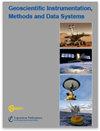A hydrate reservoir renovation device and its application in nitrogen bubble fracturing
IF 2.3
4区 地球科学
Q3 GEOSCIENCES, MULTIDISCIPLINARY
Geoscientific Instrumentation Methods and Data Systems
Pub Date : 2024-04-26
DOI:10.5194/gi-13-75-2024
引用次数: 0
Abstract
Abstract. Natural gas hydrate (GH) is a significant potential energy source due to its large reserves, wide distribution, high energy density, and low pollution. However, the gas production rate of past gas hydrate production tests is much lower than the requirement of commercial gas production. Reservoir stimulation technologies like hydraulic fractures provide one potential approach to enhance gas production from GH. The reservoir reformation behavior of the hydrate-bearing sediments (HBSs), particularly sediments with a high clay content, is a complex process during a hydraulic fracturing operation which has been poorly understood and thus hardly predictable. This paper presents an experimental facility that was developed to analyze the hydraulic fracture mechanism in synthesized HBSs. This facility can be used to form GH in sediments, conduct visual observation of hydraulic fracturing experiments, and measure the permeability of HBSs under high-pressure (up to 30 MPa) and low-temperature conditions (from 253.15 to 323.15 K). It is mainly composed of a pressure control and injection unit, a low temperature and cooling unit, a cavitation unit, a visual sapphire reactor, and a data acquisition and measurement unit. The hydraulic fracture module consists of a gas cylinder, fracturing pump, hopper, proppant warehouse, and valves. The sapphire reservoir chamber is applied to observe and measure the fracture of HBSs during hydraulic fracturing. The permeability test module is composed of a constant-flux pump and pressure sensors, which can evaluate the permeability performance before and after the hydraulic fracture in HBSs. The fundamental principles of this apparatus are discussed. Some tests were performed to verify hydraulic fracture tests, and permeability tests could be practically applied in the HBS exploitation.水合物储层改造装置及其在氮气泡压裂中的应用
摘要。天然气水合物(GH)储量大、分布广、能量密度高、污染小,是一种重要的潜在能源。然而,以往天然气水合物生产试验的产气量远低于商业天然气生产的要求。水力压裂等储层刺激技术为提高 GH 的天然气产量提供了一种潜在的方法。含水合物沉积物(HBS),尤其是粘土含量较高的沉积物的储层改造行为是水力压裂作业过程中的一个复杂过程,人们对其了解甚少,因此难以预测。本文介绍了为分析合成 HBS 的水力压裂机制而开发的实验设备。该设备可用于在沉积物中形成 GH,对水力压裂实验进行直观观察,并在高压(高达 30 兆帕)和低温(253.15 至 323.15 K)条件下测量 HBS 的渗透率。它主要由压力控制和注入单元、低温和冷却单元、空化单元、可视蓝宝石反应器以及数据采集和测量单元组成。水力压裂模块由气缸、压裂泵、料斗、支撑剂仓和阀门组成。蓝宝石储层室用于观测和测量水力压裂过程中 HBS 的裂缝。渗透率测试模块由恒定流量泵和压力传感器组成,可评估 HBS 水力压裂前后的渗透率性能。本文讨论了该设备的基本原理。进行了一些试验来验证水力压裂试验,并将渗透性试验实际应用于 HBS 的开采。
本文章由计算机程序翻译,如有差异,请以英文原文为准。
求助全文
约1分钟内获得全文
求助全文
来源期刊

Geoscientific Instrumentation Methods and Data Systems
GEOSCIENCES, MULTIDISCIPLINARYMETEOROLOGY-METEOROLOGY & ATMOSPHERIC SCIENCES
CiteScore
3.70
自引率
0.00%
发文量
23
审稿时长
37 weeks
期刊介绍:
Geoscientific Instrumentation, Methods and Data Systems (GI) is an open-access interdisciplinary electronic journal for swift publication of original articles and short communications in the area of geoscientific instruments. It covers three main areas: (i) atmospheric and geospace sciences, (ii) earth science, and (iii) ocean science. A unique feature of the journal is the emphasis on synergy between science and technology that facilitates advances in GI. These advances include but are not limited to the following:
concepts, design, and description of instrumentation and data systems;
retrieval techniques of scientific products from measurements;
calibration and data quality assessment;
uncertainty in measurements;
newly developed and planned research platforms and community instrumentation capabilities;
major national and international field campaigns and observational research programs;
new observational strategies to address societal needs in areas such as monitoring climate change and preventing natural disasters;
networking of instruments for enhancing high temporal and spatial resolution of observations.
GI has an innovative two-stage publication process involving the scientific discussion forum Geoscientific Instrumentation, Methods and Data Systems Discussions (GID), which has been designed to do the following:
foster scientific discussion;
maximize the effectiveness and transparency of scientific quality assurance;
enable rapid publication;
make scientific publications freely accessible.
 求助内容:
求助内容: 应助结果提醒方式:
应助结果提醒方式:


